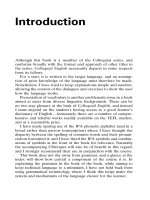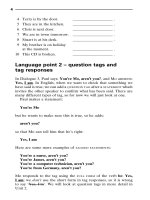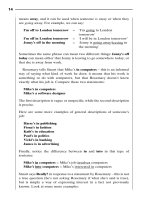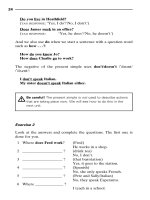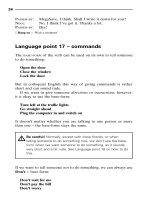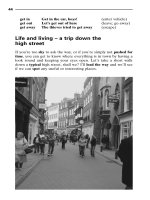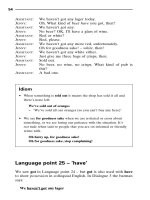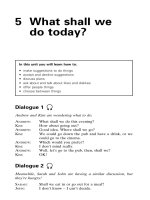Colloquial English - A Complete English Language Course doc
Bạn đang xem bản rút gọn của tài liệu. Xem và tải ngay bản đầy đủ của tài liệu tại đây (14.28 MB, 306 trang )
Colloquial
English
The Colloquial Series
Series Adviser: Gareth King
The following languages are available in the Colloquial series:
* Afrikaans
* Albanian
* Amharic
Arabic (Levantine)
* Arabic of Egypt
Arabic of the Gulf and
Saudi Arabia
Basque
* Breton
Bulgarian
* Cambodian
* Cantonese
* Chinese
* Croatian and Serbian
* Czech
* Danish
* Dutch
* English
* Estonian
* Finnish
* French
* German
* Greek
Gujarati
* Hebrew
* Hindi
* Hungarian
* Icelandic
* Indonesian
Italian
* Japanese
* Korean
* Latvian
* Lithuanian
* Malay
* Mongolian
* Norwegian
Panjabi
* Persian
* Polish
* Portuguese
* Portuguese of Brazil
* Romanian
* Russian
* Scottish Gaelic
* Slovak
* Slovene
Somali
* Spanish
* Spanish of Latin America
* Swahili
* Swedish
* Tamil
* Thai
* Turkish
* Ukrainian
Urdu
* Vietnamese
* Welsh
Accompanying cassette(s) (*and CDs) are available for all the above titles.
They can be ordered through your bookseller, or send payment with order
to Taylor & Francis/Routledge Ltd, ITPS, Cheriton House, North Way,
Andover, Hants SP10 5BE, or to Routledge Inc, 270 Madison Avenue,
New York NY 10016, USA.
COLLOQUIAL CD-ROMs
Multimedia Language Courses
Available in: Chinese, French, Portuguese and Spanish
Colloquial
English
A Complete English
Language Course
Gareth King
1111
2
3
4
5
6
7
8
9
10
11
1211
13
14
15
16
17
18
19
20
21
22
23
24
25
26
27
28
29
30
31
32
33
34
35
36
37
38
39
40
41
4211
First edition published 2005
by Routledge
2 Park Square, Milton Park, Abingdon, Oxon OX14 4RN
Simultaneously published in the USA and Canada
by Routledge
270 Madison Ave, New York NY 10016
Routledge is an imprint of the Taylor & Francis Group
© 2005 Gareth King
All rights reserved. No part of this book may be reprinted
or reproduced or utilised in any form or by any electronic,
mechanical, or other means, now known or hereafter invented,
including photocopying and recording, or in any information
storage or retrieval system, without permission in writing from
the publishers.
British Library Cataloguing in Publication Data
A catalogue record for this book is available from the
British Library
Library of Congress Cataloging in Publication Data
King, Gareth.
Colloquial English: a complete English language course /
Gareth King.
p. cm.
Includes index.
1. English language – Textbooks for foreign speakers.
2. English language – Spoken English – Problems,
exercises, etc. I. Title. II. Series.
PE1128.K43 2004
428.2′4 – dc22 2004010470
ISBN 0–415–29953–5 (pbk)
0–415–29952–7 (CD)
0–415–29950–0 (Cassette)
0–415–29951–9 (Pack)
This edition published in the Taylor and Francis e-Library, 2005.
“To purchase your own copy of this or any of Taylor & Francis or Routledge’s
collection of thousands of eBooks please go to www.eBookstore.tandf.co.uk.”
ISBN 0-203-53691-6 Master e-book ISBN
ISBN 0-203-67024-8 (Adobe eReader Format)
I dedicate this book
to the memory of my dear friend
Buzz Burrell 1956–2003
who loved the English language always
1111
2
3
4
5
6
7
8
9
10
11
1211
13
14
15
16
17
18
19
20
21
22
23
24
25
26
27
28
29
30
31
32
33
34
35
36
37
38
39
40
41
4211
Contents
Acknowledgements ix
Introduction x
English spelling xi
IPA symbols xii
Grammatical terms used in this book xiii
1 Pleased to meet you! 1
2 Where are you from? 20
3 Could you tell me where the bank is? 33
4 Have you got any bread? 47
5 What shall we do today? 64
6 Hello, could I speak to Vicki? 81
7 What date is it today? 98
8 Can I make an appointment? 117
9 I’ve lost my passport! 135
10 Which do you prefer? 155
11 I’ll see you at half past five! 175
12 You can’t be serious! 194
1111
2
3
4
5
6
7
8
9
10
11
1211
13
14
15
16
17
18
19
20
21
22
23
24
25
26
27
28
29
30
31
32
33
34
35
36
37
38
39
40
41
4211
13 The people we met were fantastic! 209
14 What would you do? 226
15 I said you’d phone back later 241
Key to exercises 259
Reference grammar 276
Irregular verbs – alphabetical list 280
Irregular verbs by type 283
Grammar index 286
viii
Acknowledgements
I thank Sophie Oliver and Suzanne Cousin at Routledge Language
Reference Editorial for their unstinting support and encouragement
throughout this project; the various reviewers of the original
proposal for their positive response and helpful feedback; Linda
Paulus, Production Editor, for her hard work and accuracy; the
Guardian and Daily Mirror newspapers for permission to use
material; my friends and colleagues in the bunker for populating a
significant proportion of the book; my fellow CaRPistas in cix:carp
for real and useful pedantry of a consistently high order; and of
course Adam, Liam and Jonquil for being the best family in the
world.
1111
2
3
4
5
6
7
8
9
10
11
1211
13
14
15
16
17
18
19
20
21
22
23
24
25
26
27
28
29
30
31
32
33
34
35
36
37
38
39
40
41
4211
Introduction
Although this book is a member of the Colloquial series, and
conforms broadly with the format and approach of other titles in
the series, Colloquial English necessarily departs in some respects
from its fellows.
For a start, it is written in the target language, and an assump-
tion of prior knowledge of the language must therefore be made.
Nonetheless, I have tried to keep explanations simple and succinct,
allowing the context of the dialogues and exercises to show the user
how the language works.
Presentation of vocabulary is another problematic issue in a book
aimed at users from diverse linguistic backgrounds. There can be
no two-way glossary at the back of Colloquial English, and instead
I must depend on the student’s having access to a good learner’s
dictionary of English – fortunately there are a number of compre-
hensive and reliable works readily available on the TEFL market,
and at a reasonable price.
I have made sparing use of the IPA phonetic alphabet (and in a
broad rather than narrow transcription) where I have thought the
disparity between the spelling of common words and their pronun-
ciation warranted it; and I have listed the IPA symbols and combin-
ations of symbols at the front of the book for reference. Naturally
the accompanying CDs/tapes will also be of benefit in this regard,
and I strongly recommend their use in conjunction with the course.
This book does not shy away from grammar, and a glance at the
index will show how central a component of the course it is. In
explaining the grammar in the body of the book, while aiming to
keep technical language to a minimum, I have not held back from
using grammatical terminology where I think this helps make the
system and mechanisms of the language clearer for the learner.
English spelling
You will see that sometimes phonetic symbols have been used to
help you with pronunciation in this book. This is because English
spelling (like French and Danish, and unlike German and Russian)
is a historic rather than a phonetic system, which means that it does
not always correspond very well to pronunciation – the words
have changed in sound while the old spelling has stayed the same.
This is a difficulty for people learning English, but it is something
that must be accepted from the start – you will have to learn
pronunciations as well as spellings. But the important thing to
remember is that English spelling does have a system – it isn’t com-
pletely illogical. It’s just that the system is sometimes a bit more
complicated than you might expect, and there are a lot of apparent
exceptions to rules.
For example, we use a ‘silent e’ as a regular component of the
system: a silent e after a single consonant changes the sound of
the vowel before the consonant: pan /pn/ but pane /pεin/; hop /hɔp/
but hope /həυp/. And sometimes we spell the same sound in
different ways – look at the different possible spellings there are for
/ɑi/: my
night time
; and for /əυ/: ho
le throw boat only soul. Or (to
take an extreme example) look at the different pronunciations of
the combination -ough: through /θru/ though /ðəυ/ bough /bɑu/
bought /bɔt/ cough /kɔf/ enough /`nf/. But don’t worry – millions
of people learn English all over the world, and they all manage
pretty well with the spelling, because the more contact you have
with the language, the easier it is. If you approach this aspect of
English with a positive frame of mind, you’ll be surprised how
quickly you get used to it!
1111
2
3
4
5
6
7
8
9
10
11
1211
13
14
15
16
17
18
19
20
21
22
23
24
25
26
27
28
29
30
31
32
33
34
35
36
37
38
39
40
41
4211
IPA symbols
Vowels Consonants
/ə/ butter, sofa /b/ book, able
// cat, hand /k/ come, look
/ɑ/ father, farm // children, which
/ε/ get, send /d/ red, down
// sit, win /f/ fall, if
/i/ happy // go, leg
/i/ feel, machine // Gerry, Jenny
/ɔ/ long, top /h/ have, hand
/ɔ/ fall, thought /l/ look, milk
/υ/ full, book /m/ man, come
/u/ do, cool /n/ now, run
// cup, some /ŋ/ bring, running
// bird, hurt /p/ paper, cup
/kw/ quite, quick
/r/ red, arrive
Diphthongs
/
r
/ car, four
†
/εi/ say, eight /s/ send, miss
/ɑi/ my, night /ʃ/ should, wish
/ɔi/ boy /t/ it, time
/əυ/ boat, home /θ/ think, three
/ɑu/ now, found /ð/ the, with
/ə/ hear, here /v/ very, give
/εə/ hair, where /w/ want, when
/υə/ sure /j/ yes, you
/z/ prize, rose
/`/ (precedes stressed syllable) // measure
†
silent before consonant and at end of sentence
Grammatical terms
used in this book
action verb – a verb that describes a dynamic action or event: run,
read, throw, phone.
active – a sentence structure where the doer of the action is the
subject: the dog
bit the postman.
adjective – a word that describes a noun: red, heavy, electronic,
difficult.
adverb – a word that describes how, where or when an action or
event takes place: quickly, here, tomorrow.
auxiliary – a special verb that is used with another (main) verb:
I was
going, he didn’t come; compare modal auxiliary.
base-form – the normal dictionary form of the verb, without any
endings: come, go, study, drive, stop.
C1 – a type of conditional tense: if he arrives late.
C2 – a type of conditional tense: if he arrived late.
clause – a part of a sentence that includes a verb.
comparative – the form of the adjective that shows a higher degree:
cheaper, bigger, more expensive.
conditional – a tense of the verb that indicates hypothetical
situations: I’d read a book. There are two main conditional
tenses in English: C1 and C2.
consonant – in writing, the following letters: b c d f g h j k l m n p q
r s t v w x y z; compare vowel. But consonant sounds can
sometimes be written as vowels: u
niversity.
definite article – the word the.
degree words – words that describe the degree of an adjective: very
small, quite expensive, awfully clever.
direct object – the person or thing that receives the action of the
verb: we saw the concert
.
direct speech – the actual words someone said, put in the sentence
as a quote: She said: He isn’t coming; compare reported speech.
1111
2
3
4
5
6
7
8
9
10
11
1211
13
14
15
16
17
18
19
20
21
22
23
24
25
26
27
28
29
30
31
32
33
34
35
36
37
38
39
40
41
4211
ed-form – the regular past tense form of the verb: smiled, stopped,
studied, asked.
empty it – in some sentence structures, an it that doesn’t refer to
anything specific, but is required for grammatical reasons: it’s
raining, it’s nice to see you.
full form – see short form.
future – a tense of the verb – there are three main ways of doing the
future in English: I will write, I’m writing, I’m going to write.
genitive – a form of the noun denoting possession or relationship:
John’s
book, the middle of the road.
indefinite article – the word a/an.
indirect object – the person or thing that receives the direct object
of the verb: we gave the girl
(INDIRECT OBJECT
) a book
(DIRECT
OBJECT
).
indirect speech – another term for reported speech.
ing-form – the form of the verb ending in -ing: coming, going,
studying, driving, stopping; used in the continuous tenses, and
in other ways.
irregular verb – a verb that doesn’t form its past simple tense by
adding -ed: flew (fly), came (come), went (go), made (make).
modal auxiliary – special auxiliary verbs that have their own
meanings, but are used with other verbs: he can
speak English,
you shouldn’t
go.
negative – the form of the verb that tells you that something doesn’t,
didn’t or won’t happen.
noun – a word that names a thing, person, place or idea: cat, James,
London, honesty.
object – the thing or person that receives the action in a sentence:
Liz fed the cats
; compare subject.
passive – a sentence structure where the receiver of the action is the
subject: the postman
was bitten by the dog; compare active.
past continuous – a tense of the verb that indicates ongoing action
in the past: I was reading.
past participle – the form of the verb used with have to form the
present perfect tense: I’ve arrived
, she’s gone.
past perfect – a tense of the verb one stage back in the past from the
present perfect: I had broken my leg.
past simple – a tense of the verb that indicates completed action in
the past: I stopped.
phrasal verb – a combination of verb + adverb which has a special
meaning: blow up, turn off, take off.
xiv
possessive adjective – words that tell you who something belongs to:
my, your, his.
preposition – a word that shows the relationship between nouns, or
nouns and pronouns: at, by, for, to, with.
present continuous – a tense of the verb that indicates ongoing
action at the time of speaking, or future intention: I’m reading.
present perfect – a tense of the verb indicating an action or event
that has happened very recently: I’ve broken my leg.
present simple – a tense of the verb that indicates habitual action in
the present, or state: I read every day.
pronoun – a word which stands in place of a noun: I, me, you, he,
him, she, her, we, us, they, them.
regular verb – a verb that forms its past simple tense by adding -ed.
relative clause – a clause that adds information about the main
clause in a complex sentence: The man we saw yesterday
is here
again today.
reported speech – someone’s actual words incorporated into a
sentence: She said he wasn’t coming
; compare direct speech.
s-form – the
BASE-FORM of the verb with -s or -es added: comes, goes,
studies, drives, stops.
short form – colloquial shortened forms of verbs, such as I’m for
I am, and wasn’t for was not; I am and was not are full forms.
statement – the positive form of the verb, stating that something
does, did or will happen.
state verb – a verb that describes a continuing physical or mental
state, or an unchanging situation: know, belong, mean, contain;
compare action verb.
strong form – some common words have two pronunciations: a full
pronunciation used only when emphasising the word (
STRONG
FORM
), and a weak pronunciation used in all other circum-
stances; see Language point 13.
subject – the doer of the action in a sentence: the postman
delivered
the letter; compare object.
superlative – the form of the adjective that shows the highest degree:
the cheapest, the biggest, the most expensive.
to-form – the
BASE-FORM of the verb with to added to the front: to
come, to go, to study, to drive, to stop. Sometimes called the
to-
INFINITIVE.
verb – a word that describes an action or event.
vowel – in writing, the following letters: a e i o u.
1111
2
3
4
5
6
7
8
9
10
11
1211
13
14
15
16
17
18
19
20
21
22
23
24
25
26
27
28
29
30
31
32
33
34
35
36
37
38
39
40
41
4211
xv
weak form – the normal pronunciation of a word that also has a
full pronunciation for emphasis; see strong form and Language
point 13.
wh-word – any of these question words: who?, what?, where?, why?,
when?, which?, whose?, how?.
xvi
1 Pleased to
meet you!
In this unit you will learn how to:
• greet people
• say goodbye to people
• introduce yourself to someone
• introduce someone to someone else
• identify people
Dialogue 1
VICKI: Hello, I’m Vicki.
H
ELEN: Hello, Vicki. My name’s
Helen.
V
ICKI: Pleased to meet
you.
H
ELEN: And you.
Dialogue 2
STUART: I’m Stuart.
J
ENNY: Hello Stuart. I’m Jenny.
S
TUART: Nice to meet you.
J
ENNY: And you.
1111
2
3
4
5
6
7
8
9
10
11
1211
13
14
15
16
17
18
19
20
21
22
23
24
25
26
27
28
29
30
31
32
33
34
35
36
37
38
39
40
41
4211
Dialogue 3
Paul introduces himself to Mo.
P
AUL: Hello – you’re Mo, aren’t you?
M
O: Yes, I am. And what’s your name?
P
AUL: I’m Paul – pleased to meet you.
M
O: Pleased to meet you too.
Language point 1 – short forms
Introducing yourself and finding out people’s names always involves
the verb be. For example, if Jenny wants to tell someone her name,
she can just say I’m Jenny, or she can say My name’s Jenny. To find
out someone else’s name, she says What’s your name? All these
phrases contain special
SHORT FORMS of the verb be. Let’s have a
look at how they work.
In colloquial English – when we are speaking in informal situa-
tions – we use special
SHORT FORMS
for some verbs. So, in Dialogue
1, Vicki says:
I’m Vicki
• I’m is the short form for the
FULL FORM I am.
And in Dialogue 3, Paul says:
you’re Mo
• you’re is the short form for the full form you are.
With verbs that have short forms (not only be but also have, do and
some others that we will meet later) we do not normally use the full
form in speaking except when we want to put special emphasis
on the verb. (But we have to use the full form in
TAG RESPONSES –
see next Language point.)
So, for the present tense of be we have short forms for all
persons:
2
Full form Short form
I am /a m/ I’m /ɑim/
you are /ju: ɑ:
r
/ you’re /jɔ:
r
/
he is /hi: z/ he’s /hi:z/
she is /ʃi: z/ she’s /ʃi:z/
it is /t z/ it’s /ts/
we are /wi: ɑ:
r
/ we’re /wə
r
/
they are /ðε ɑ:
r
/ they’re /ðεə
r
/
Pay attention to the pronunciation of these short forms in British
English, and notice that all the full forms have two syllables, while
the short forms all have one.
Be careful with the he/she short form ’s – you can’t use it after a
name ending in -s, -ch, -sh, -x or -z. So we say:
Fred’s here Fiona’s here Terry’s here
Brian’s here John’s here
but
James is here Rich is here Trish is here
Max is here Baz is here
not
James’s here
Rich’s here Trish’s here
Max’s here Baz’s here
We will see some more short forms in the next unit. It is important
to know how to use them as they form a common and typical feature
of colloquial English everywhere.
Exercise 1
Turn the full forms into short forms in these sentences. Be careful
– one of them can’t be changed to a short form! The first one has
been done for you.
1 Brian is in work today. Brian’s in work today.
2 Hello, I am Fred. ____________________ .
3 Sue is over there. ____________________ .
1111
2
3
4
5
6
7
8
9
10
11
1211
13
14
15
16
17
18
19
20
21
22
23
24
25
26
27
28
29
30
31
32
33
34
35
36
37
38
39
40
411
4211
3
4 Terry is by the door. ____________________ .
5 They are in the kitchen. ____________________ .
6 Chris is next door. ____________________ .
7 We are in town tomorrow. ____________________ .
8 Stuart is at his desk. ____________________ .
9 My brother is on holiday
at the moment. ____________________ .
10 This CD is broken. ____________________ .
Language point 2 – question tags and
tag responses
In Dialogue 3, Paul says: You’re Mo, aren’t you?, and Mo answers:
Yes, I am
. In English, when we want to check that something we
have said is true, we can add a
QUESTION TAG
after a STATEMENT which
invites the other speaker to confirm what has been said. There are
many different types of tag, so for now we will just look at one.
Paul makes a statement:
You’re Mo
but he wants to make sure this is true, so he adds:
aren’t you?
so that Mo can tell him that he’s right:
Yes, I am
Here are some more examples of
TAGGED STATEMENTS:
You’re a nurse, aren’t you?
You’re James, aren’t you?
You’re a computer technician, aren’t you?
You’re from Germany, aren’t you?
Mo responds to the tag using the
FULL FORM of the verb be: Yes,
I am
; we don’t use the short form in tag responses, so it is wrong
to say ‘Yes, I’m
’. We will look at question tags in more detail in
Unit 2.
4
Exercise 2
Add the correct question tags to these sentences – the first one has
been done for you.
1 You’re a teacher, aren’t you?
2 Simon’s a footballer, ______ ?
3 Suzie’s a nurse, ______ ?
4 Pete and Dave are lawyers, ______ ?
5 Ela’s from Poland, _____ ?
6 This food’s delicious, ____ ?
7 We’re a bit late, ____ ?
8 It’s cold this morning, ____ ?
9 You’re from Finland, ____ ?
10 Ilse’s from Austria, ____ ?
Dialogue 4
Rosemary wants to introduce Justine and Tim to Stuart, who doesn’t
know them.
ROSEMARY: Stuart, this is Justine.
S
TUART: Hello, Justine.
J
USTINE: Pleased to meet you, Stuart.
R
OSEMARY
: And this is Tim.
T
IM: Hello, Stuart.
Dialogue 5
Justine introduces Vicki to Chris.
J
USTINE
: Vicki – do you know Chris?
V
ICKI: I don’t think so.
J
USTINE: Chris, this is Vicki.
C
HRIS: Hello Vicki.
V
ICKI
: Hello Chris. Pleased to meet you.
Language point 3 – introducing people
You can find out if someone knows someone else, or introduce two
people who don’t know each other, by asking one of them Do you
know . . .? followed by the name of the other person.
1111
2
3
4
5
6
7
8
9
10
11
1211
13
14
15
16
17
18
19
20
21
22
23
24
25
26
27
28
29
30
31
32
33
34
35
36
37
38
39
40
41
4211
5
Vicki answers with I don’t think so, not because she isn’t sure
but because this is a more indirect way of saying No – it would
sound rather short just to say ‘No’. Let’s look at another example
of two people being introduced to each other:
Dialogue 6
Stuart is seeing if he can remember the names of everyone in the
room.
STUART: Now then, are you Helen?
H
ELEN: Yes, I am.
S
TUART: And is that Su by the door?
H
ELEN: Yes, it is.
Stuart turns to another person.
S
TUART: And are you Jenny?
J
ENNY: Yes, I am!
Stuart points to someone else.
S
TUART
: And is she Ann?
J
ENNY: Yes she is! Well done!
Dialogue 7
Su is talking to Shamira in the office.
S
U
: Is the coffee ready?
S
HAMIRA: Yes, it is.
S
U: Good. Where’s the sugar?
S
HAMIRA: It’s over there on the table.
Su looks for the sugar.
S
U: Are you sure, Shamira?
Shamira looks as well.
S
HAMIRA: Oh no – here it is, on Tim’s desk.
S
U: Is Tim off today?
S
HAMIRA: Yes, he is. He’s ill.
S
U: Poor Tim. Coffee for two, then?
6
Language point 4 – questions with the
verb ‘be’
We turn statements using the verb be into questions by simply
changing the order of the pronoun (I, you, he, she, it, etc.) and verb
in the full form. So:
Statement (full form) Question
I am am I?
you are are you?
he is is he?
she is is she?
Kevin is is Kevin?
we are are we?
they are are they?
Ann and Jenny are are Ann and Jenny?
Notice that there is no short form for questions: for example, instead
of he is we usually say he’s, but we cannot say ‘’s he?
’ instead of
is he?
(Most verbs in English don’t form questions in this way, as we
will see in later units – but this is always the way to make questions
with be.)
Exercise 3
Turn these statements into questions – remember to use full forms!
The first one has been done for you.
1 I’m late. Am I late?
2 Dave’s off work today. _______________ ?
3 It’s cold outside. _______________ ?
4 We’re in the right place. _______________ ?
5 Everyone’s ready. _______________ ?
6 You’re tired. _______________ ?
7 They’re in the garden. _______________ ?
8 Morgan and Eddie are here. _______________ ?
9 Oliver’s outside. _______________ ?
10 Jenny’s inside. _______________ ?
1111
2
3
4
5
6
7
8
9
10
11
1211
13
14
15
16
17
18
19
20
21
22
23
24
25
26
27
28
29
30
31
32
33
34
35
36
37
38
39
40
41
4211
7
Dialogue 8
Brian is having trouble with names and faces.
B
RIAN: Is that Gerry over there?
S
TUART: Yes, it is.
B
RIAN: And who’s that with him?
S
TUART: That’s Ben.
B
RIAN: And where’s Sandra?
S
TUART: She’s over there, by the window.
B
RIAN: Oh yes – and who’s that with her?
S
TUART: That’s Dave.
Dialogue 9
Ben has a list of names of people in the office, but he doesn’t know
who’s who! He asks Justine to help, and she points them out as he
reads out the names.
B
EN: Right. Where’s Helen?
J
USTINE: That’s her, by the door.
B
EN: And Stuart?
J
USTINE: That’s him, at the computer.
B
EN: And what about Gerry and Adrian?
J
USTINE: That’s them, by the coffee-machine.
B
EN: And finally what about Justine?
J
USTINE: That’s me, silly!
8

